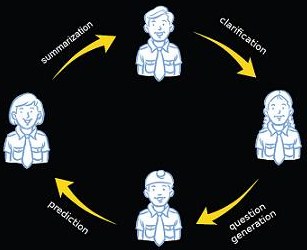 Make your classroom a collaborative learning community
Make your classroom a collaborative learning community
The reciprocal-learning teaching method, developed and tested in the 1980’s by psychologist Ann Brown and her colleagues, is a way to make your classroom a collaborative learning community, where students take charge of their own learning. It uses dialogue among students (and a teacher) as a means to understanding challenging text material, and in the process improve the students’ skills. The text can belong to any subject, and must be divided into smaller segments, usually paragraphs. But if you have a large class, don’t despair. You can use the basic ideas of reciprocal-learning teaching by creating small groups of students and minimal teacher support.
Just divide your class giving guidance and help where necessary. Everybody reads a paragraph together, and then one student summarizes it in her own words. The next student clarifies any parts that are difficult to understand, or possible inconsistencies, with the help of the group. A third student asks a question based on the text. This could be a question, the answer to which can be found in the paragraph itself, or it could be a question sparked off by the reading. Another student predicts the content of the next paragraph, based on the text so far and his own general knowledge on the topic. The group now moves on to the next segment of text, and the process repeats itself with another set of four students.
Initially, you as the teacher will have to demonstrate the four skills needed. Gradually, your students will get the hang of it and will be able to continue on their own.
On paper, the method almost sounds too simple to be effective, but just try it! It quickly changes the depth at which students are reading the text, and the level of understanding they gain. Gradually, this method of reading difficult text is internalized by the students, so that increasingly they read to learn, and are able to monitor their own understanding of the material.
